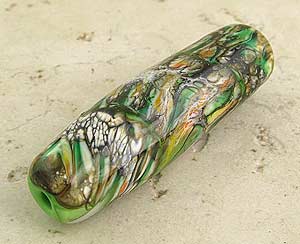 Over at Torchbugs you can find all kinds of glass bead making tutorials. Today I’m sharing some I really like. Silvered Ivory Stringer is one of the coolest component parts a bead making can make and use. Silver foil is mixed up with ivory glass and the reactions are fabulous. Check out this tutorial so you too can make and use this great component. The beads that come out of it are interesting and organic and just awesome. This tutorial is provided by Rosemarie Hanus of Spawn of Flame.
Over at Torchbugs you can find all kinds of glass bead making tutorials. Today I’m sharing some I really like. Silvered Ivory Stringer is one of the coolest component parts a bead making can make and use. Silver foil is mixed up with ivory glass and the reactions are fabulous. Check out this tutorial so you too can make and use this great component. The beads that come out of it are interesting and organic and just awesome. This tutorial is provided by Rosemarie Hanus of Spawn of Flame.
